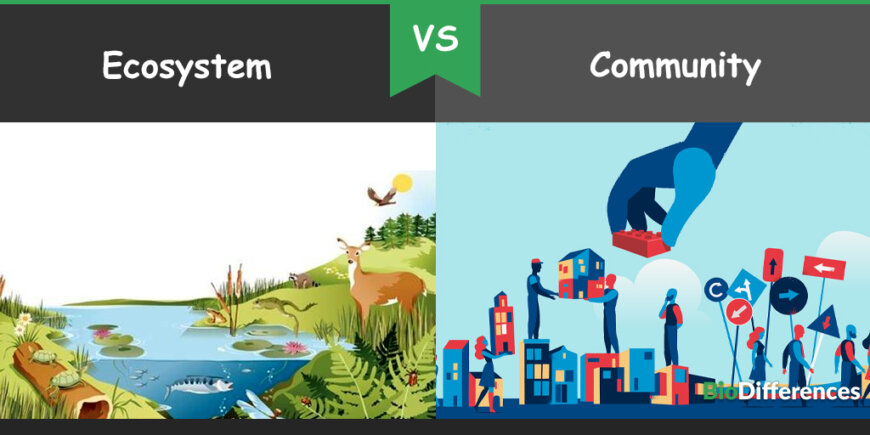Earth is the only planet consisting of life from the microscopic organisms to the larger animal. To understand the management, activity and organization of life, it is better to understand a few terms such as biosphere, biome, ecology, individual, population and community.

The main difference between ecosystem and community is that ecosystem comprises of various communities, which contain living as well as non-living components interacting with each other. On the other hand, the community is the interaction of different individuals of populations of different species living in a particular geographical area. The community consists of only living components.
Contents
Comparison Chart
| Basis for Comparison | Ecosystem | Community |
| Definition | An ecosystem can be defined as a link between the living and non-living components for the exchange of energy and biogeochemical cycling. | The community can be defined as a group of populations of different species living together and interacting and with them in a region. |
| Components | All biotic and non-biotic factors | Only biotic factors |
| Structured by | Predation, Competition, environmental factors | Predation and Competition |
| Size | Larger than a community | Smaller than an ecosystem |
| Changes in the environmental factors | Does not affected by the environmental factors | Does affected by the environmental factors |
| Example | A forest, a pond or a grassland | Different species of birds living in the same area |
What is the ecosystem?
The person who studies the ecosystem is called an ecologist. Ecologist defines the ecosystem as the atmosphere where biotic and abiotic factors interact with each other. Hence, biotic factors include all kinds of living beings like small microorganisms to the big organisms interacting with abiotic factors such as ocean, mountains, river, sun, rocks and clouds, etc.
Both the abundance of the populations of each organism and the nature of the environmental factors can change the ecosystem. The ecosystem is larger than the community in size. Community is part of the ecosystem. The ecosystem consists of a community plus the environmental factors affecting it.
Ecosystems can be of different types; aquatic, terrestrial, or marine. The pond is an example of an aquatic ecosystem. Forest is the example of a terrestrial ecosystem, whereas the ocean depicts the example of the marine ecosystem. Ecologist uses two parameters related to the ecosystem, which are resilience and resistance. Resilience is the disturbance in an equilibrium of the ecosystem, whereas resistance is the return of the state of the equilibrium of an ecosystem.
Although each ecosystem is unique, a few standard components are part of each ecosystem, which are producer, consumer and decomposer. Producers play a vital role in the production of energy. Producers prepare their food with the help of using sunlight. The best example of producers is plants that prepare their food by the process of photosynthesis using sunlight. Consumers depend on the producers directly or indirectly for the food. Animals are an example of consumers who eat plants. Decomposers decompose the materials and convert them into the soil. Bacteria and fungi are examples of decomposers.
What is a community?
All the living organisms vary with one another in different aspects, but they cannot live alone on the earth. They need support from each other to survive. Hence, the community can be defined as the interaction of the living organisms with the different types of species inhabiting together in the same environment as well as in a specific region.
For the survival in a community, organisms depend on each other and make relationships. Three types of interactions can exist within the living organisms in a community; mutualism, commensalism and predation. Mutualism is the interaction in which both parties in the relationship get benefit from each other. In commensalism, one organism in the relationship gets the advantage, whereas the second organism remains neutral. In predation, one organism receives the benefit, but the second organism is harmed.
The community represents the biotic factor of an ecosystem as it comprises the organisms in the food chains in an ecosystem. So the biological community is involved in the flow of energy in an ecosystem. On the other hand, the members of a community are involved in the recycling of the materials as well.
The community is the part of an ecosystem that consists of populations of different types of species living together. There is the level of hierarchy that is followed to reach the top level called the Biosphere. This top-level is the point where all the biomes and ecosystems meet and it is a sum of the factors right from the individual level to the biomes.
Key Differences
- The ecosystem consists of all biotic and abiotic components, whereas the community consists of only biotic components.
- The ecosystem is structured by predation, competition and environmental factors, whereas the community is structured by predation and competition.
- The ecosystem is larger than the community, whereas the community is smaller than the ecosystem.
- The ecosystem is not affected by environmental factors, whereas the community is affected by environmental factors.
Key Similarities
- Both ecosystems and communities describe the interaction between living organisms.
- Both ecosystems and communities play a significant role in the energy flow and the recycling of nutrients in the environment.
Conclusion
In conclusion, ecosystem and community are two ecological terms that describe the distribution of the species in a particular geographical environment. Both represent the interactions between living organisms.